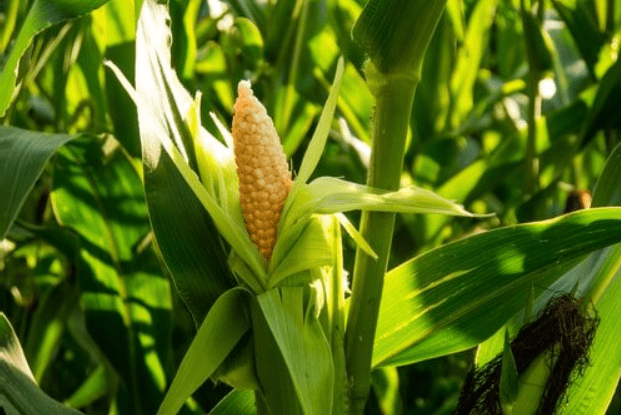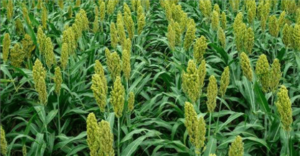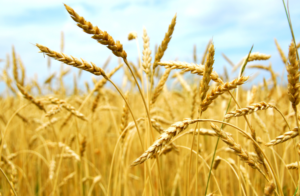MAIZE CROP

Scientific name= Zea mays L.
Origin= Southern Mexico and Central America.
v Area Distribution=
· In all over world:
USA, China, Beazil, India, Mexico, France, Africa, Russia, etc.
· In India:
Rajasthan, Uttar Pradesh, Madhya Pradesh, Andhra Pradesh, Gujarat, Himachal Pradesh, Karnataka, Bihar etc.
v Classification:
They are classified in 7 groups based on the endosperm kernels:
· Dent corn (Zea mays indentata sturt)
· Flint corn (Zea mays indurate sturt)
· Popcorn (Zea mays everta sturt)
· Soft corn (Zea mays amylacea sturt)
· Sweet corn (Zea mays saccharate sturt)
· Popcorn (Zea mays tunicate)
· Waxy corn (Zea mays ceratina Kulesh)
v Varieties:
· Hybrids:
Sartaj, Gagan 11, Trishulata, Deccan 1or107, VL 42.
· Composites:
Dhawal, Tarun, Navin, Shweta, Navjot, Kiran, Kanchan, D 765, Surya, VL Makka 88, Hara Bahar (African tall), Madhuri (sweet corn), Amber (Popcorn), VL Amber (Popcorn).
v Importance=
· Mazie
is one of the most important cereal crops in the global agriculture economy.
· Maize
crop is used as a food for man and as a feed for animals.
· It has
very high yield potential.
· There
is no cereal on the earth which has such immense potentiality, and that is why
it is also known as queen of cereals.
· Maize
crop is utilized in many ways like other grain crops.
· Over
85% of maize produced in the country is consumed as human food.
· Green
cobs are roasted and eaten by people with great interest.
v Cultivation Practices:
a. Soil Requirement :
· Fertile, deep and well-drained soils are necessary for maize.
· P.H.= 7.5-8.5
b. Climatic requirement:
· Temperature: 18-30 degree.
· Rain fall: 60-110cm
· Relative humidity: 75-80% approximately
a. Sowing time:
|
Crop Region |
Sowing Time |
|
Indo-Gangetic
plains and Andhra Pradesh |
Mid-June-Mid
July |
|
Peninsular
India |
May-
June |
|
North-
Eastern Hills |
First
week of March |
|
North-
Westen Hills |
April
end- early May |
b. Spacing:
· Row to row: 60-75 cm
· Plant to plant: 25-30 cm
Seed rate: 20-25 kg/ha
e. Field Preparation:
· Give four to five ploughing and planking to make the seed-bed free from clods and weeds.
· Use mould board plough, disc harrow or cultivator for the 1st cultivation.
f. Irrigation practices:
· 4-6 irrigations are required depending upon rain-fall.
· Critical stages for irrigation- Tasselling and silking.
g. Nutrient and fertilizer management:
· Hybrid verities: 120:50:40 NPK kg/ha.
· Composite verities: 100:40:30 NPK kg/ha.
· Paddy straw compost @180 kg per acre along with recommended dose of fertilizer.
· FYM: 20-25 tons/ha
a. Weed Control methods
Mechanical methods
They are many mechanical methods are used for controlling weed management. They are following:
a. Hand pulling
b. Hand weeding
c. Burning
d. Flooding
e. Hoeing
f. Tillage
g. Smothering with non-living material(mulching).
h. Earthing up
Chemical method
They are many herbicides used in maize crop. They are following:
· Pre plant incorporated:
o Trifluralin 0.8-1.20 kg/ha
o Butylate 4.0-60 kg/ha
o Fluchloralin 0.9-1.0 kg/ha
· Pre emergence:
o Atrazine and simazine @1-2 kg/ha to control grasses and broad-leaved weeds effectively. Atrazine can be applied at any stage of crop that is pre (or) post emergence.
o Alachlor and Metolachlor @1-2 kg/ha as pre-emergence are effective against annual grosses but these are weak on broad leaf.
o Pendimethalin 1-1.5 kg/ ha.
· Post emergence:
o 2,4-D or
o MCPA (0.25-0.5 kg/ha) used as directed spray between 8 and 25 cm whorl height stage of crop to control the broad-leaved weeds.
o Metsulfuron-methyl 0.30-0.50 kg/ha
o Tembotrione 125-150 g/ha with surfactant (20 DAS) or without (30 DAS) surfactant.
a. Harvesting:
· Harvesting can be start when the husk is turned yellow and grains are hard enough having less than 30% moisture.
· Remove the husk from the cobs and dry them in sun for 7-8 days.
· There after grains are removed either by beating the cobs by stick or with the help of maize shellers.
b. Yield:
· In hybrid: 50-60 q/ha.
· In composites: 45-50 q/ha
Other important links:
Maize crop disease: Maize
Crop Diseases | agriculturestudymaterial
ICAR: ICAR-Indian
Institute of Maize Research
Other agronomy crops links:
Wheat
crop: WHEAT CROP | agriculturestudymaterial
Rice crop: RICE
CROP | agriculturestudymaterial




Hi there all, here every person is sharing these kinds of familiarity, therefore it’s fastidious to read this website, and I used to go to see this webpage everyday.